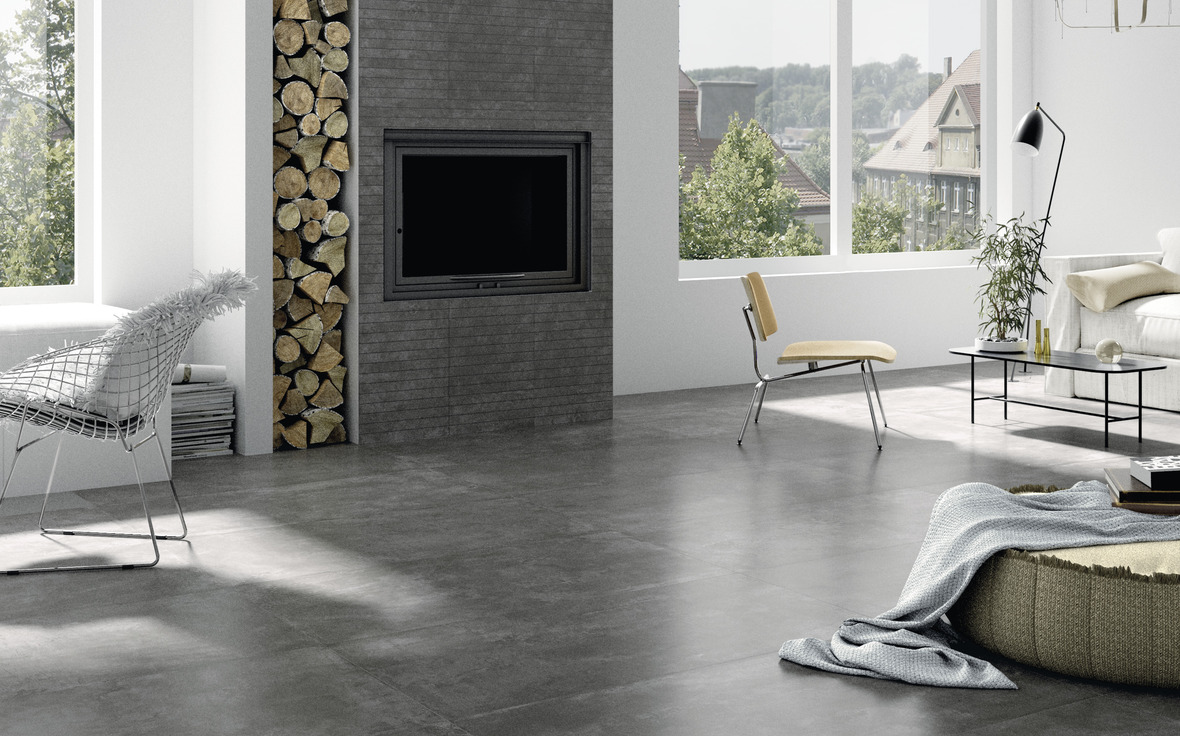

Laying
In addition to the technical and aesthetic qualities of the material, in order to be a complete success an Iris Ceramica floor also requires elements such as a foundation, an
adhesive layer and expansion joints, which together comprise a real flooring system. A perfect end result is only guaranteed if the laying operations are performed correctly.
The floor should preferably be laid using adhesives, following the instructions provided by the adhesive manufacturers.
For tiles measuring over 16 cm2 and for floors subject to intensive use, a double layer system is advisable.
For decorative tiles with precious material inserts, it is advisable to consult the instructions on the packaging.
To make the most of the material characteristics, we recommend following these instructions during the laying process:
• Lay out a few pieces on the floor (at least 3 m2) to check the overall effect. Lay material from several different boxes at once.
• Do not immerse the material in water before laying.
• If using the traditional laying system, tap the material until all the cavities and air bubbles have completely disappeared from the mortar and until liquid cement comes up through the spaces between the tiles.
• In the case of polished surfaces in particular, do not use pencils or pens to mark out cuts on the top of the tiles to be laid.
• Wait 48-72 hours before subjecting the floor to everyday use.
How to cut Use suitable, professional tools, always checking their cutting capacity and replacing consumable parts when necessary. For accurate cutting, use a traditional cutter, checking the condition of the cutting wheel before use. For circular cuts, create a template and place it on the part in question, marking out the cut in pencil. Using an angle grinder with diamond blade, proceed to make the cut without applying too much pressure.
How to make a hole You will need to use a water grinder or an angle grinder with continuous rim diamond blades for stoneware and granite. After having marked out a square within which to cut the hole on the back of the tile, start cutting by moving the grinder perpendicularly and diagonally, then working in concentric circles towards the outside. When the central thickness of the hole has become very thin, turn the tile over and open the hole by means of gentle taps. When making holes in the facing, you will need a drill and diamond bits for granite. It is important to remember to cool them regularly when in use.
Dismantling the floor
Selecting building material on the basis of its durability is fundamental in terms of the environmental sustainability of a building. In fact, a material with a longer life cycle than
another comparable material has a lower environmental impact.
If correctly installed, Iris Ceramica’s materials can last as long as the building in which they have been used. Moreover, at the end of their useful life, the residue deriving from
their demolition does not need to be treated as they do not release substances into the environment, thanks to their high level of chemical inertia.
The waste generated should be salvaged or disposed of, in compliance with current national and local legislation.
• When using normal drying adhesives, grout the floor after 24-48 hours; when using rapid drying adhesives, grout after 4 hours.
• When working with polished materials in particular, use cement grouts of a matching tone, avoiding dark coloured grouts with pale materials, and vice versa.
When grouting these surfaces, it is advisable not to use flexible mortars made from synthetic materials (Flexfughe), especially if the colour contrasts that of the material, and not to use grout additives/latex. In fact, these products make it extremely difficult to remove any residue using normal cleaning products. If using grouts with contrasting or special pigments, take care to follow the information provided in the specifications and test the grout on the material beforehand.
• Use a rubber-coated spatula to apply the grout over the entire surface of the material.
• Grout small areas at a time, removing excess quantities with damp sponges or cloths (using clean water only) or specific equipment for removing excess grout, while the layer of grout is still damp.
• Adequate initial cleaning is fundamental to get the best shine and to ensure cleanability and easy everyday maintenance. Initial cleaning should therefore be performed immediately after laying, using acid-based products, scrubbing hard and rinsing with plenty of water. This will make it possible to remove any grout, adhesive and cement residue, etc. You may use any detergent available on the market, with the sole exception of products containing hydrofluoric acid (compounds and derivatives) as provided for by standard EN 14411.
• We recommend protecting the laid flooring carefully. When carrying out other operations such as painting, plumbing or any other work, we recommend covering the floor with PVC sheets, airballs or fabrics once it has been laid.